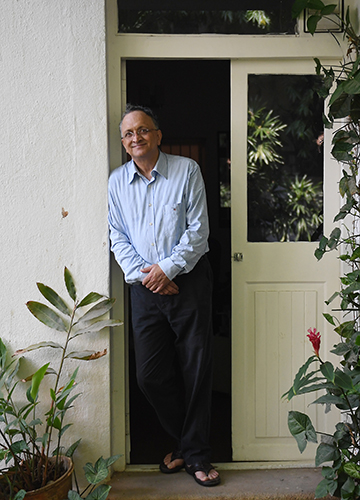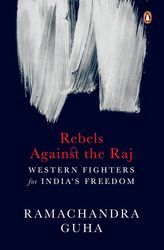The bookcases are ceiling high. A blue bust of Ambedkar sits companionably next to Gandhi. “I don’t want to choose between them,’’ says Ramachandra Guha. It is a bright, blue-skied evening in Bengaluru. Outside Guha’s study, one can see a frangipani tree, its leaves glossy green—a serious historian’s perfect escape from poring over minute print.
And Guha is certainly that. His new book, Rebels Against the Raj, is a vivid portrait of seven foreigners who rebelled against the Raj, from the well-known ‘Mother’ Annie Besant to the lesser-known R. R. Keithahn. They came to India, got swept up in the freedom movement and fought against the empire. There are three women: Besant; Madeleine Slade, more popularly known as Mira Behn; and Catherine Mary Heilman, who became Sarala Behn and settled in the village of Kasauni in Uttarakhand to start a school for girls. “What binds them is that they all have a connection to Gandhi,” says Guha. “Each of their relationship with Gandhi sheds new light on him. All of them have interactions with him, which showed his many-sidedness—the visionary, the caring leader, and occasionally, in his private life, the stubborn, unfeeling and partly authoritarian figure. Of course, he was the towering figure of the age. So if you engaged in politics or activism, you had to reckon with him. This is what they all did in different ways.”
There is Benjamin Guy Horniman—the legendary editor of The Bombay Chronicle, who lived in a bungalow in Worli with his dogs. The man, after whom a well-known circle in the heart of the city is named, used to take a walk after lunch from his office at the Sentinel to the public gardens in front of the Asiatic Society with breadcrumbs for birds and change for the street urchins. But beyond the eccentricities, he was also a man who combined activism and journalism comfortably. The founder of the Press Association of India in 1915, a union for working journalism, Horniman represents the best of the trade—fiery, committed, wily, witty and entertaining. Deported from India in 1919, Horniman’s passport was impounded. It was Horniman who exposed the brutality of what happened in Jallianwala Bagh from England. After several attempts over years to get the Foreign Office to reissue it, he finally had to find a loophole to enter India, through Ceylon.
The book comes at a time when Bapu’s favourite hymn, ‘Abide With Me’, is off the playlist. The brand of nationalism now on display is homegrown, homespun and often shrill. “I think that the greatest aspect of our freedom movement was that it was open to ideas,” says Guha. “I talk of nationalism having two children—patriotism and jingoism. The Indian idea was patriotism, but now it has gone into jingoism and xenophobia. It has become about racial purity. I think the closest parallel today is Russia and Turkey. Two great civilisations like India, and like India, they have had deep philosophical, historical, architectural and cultural traditions, and yet they also have drawn from elsewhere. But Putin in Russia, Erdogan in Turkey and Modi in India want to cast themselves as returning the nation to its true original, unsullied past, which never existed. They are the symbol of this resurgence, but actually it is not a resurgence, it is a narrowing in. Both Turkey and Russia are cautionary examples, because about 20 years ago both had enormous potential. Turkey could have been part of Europe. Russia had enormous scientific infrastructure and natural resources. They could have been high-quality modern states. Instead they are fighting these battles—Turkey with the Kurds, Russia with Ukraine, and India with its own people. It is mystifying how more people don’t recognise the dangerous path xenophobia takes you down.”
Guha has chosen his cast of characters carefully. Each of the seven was shaped by India and left behind a legacy. Apart from the fiery women, there is Benjamin Samuel Evans Stokes, an American who was a member of the Church Missionary Society. “Disgusted by the luxurious lifestyles of the European priests in India”, Stokes married an Indian, fought against the system of begar (forced labour) in Himachal Pradesh and introduced apples in the state. Philip Spratt, an active member of the Communist party who was later cured of the revolutionary left by Gandhi, married an Indian, Seetha. And finally, Ralph Richard Keithahn—who was also a man of the cloth, but worked out of the church.
“The one person I was very familiar with was Annie Besant,” says Guha. “I thought of not including her. But then I felt that her story needed to be retold for a younger audience. Young people don’t know about her. They know her as a road in Bombay, and Horniman as a circle in Bombay. What is interesting is that the year she comes to India—1893—was the year Vivekananda went to Chicago, Gandhi went to South Africa and Ranjitsinhji ‘Ranji’ played for Cambridge at Lord’s. I thought that was a nice juxtaposition, so I decided to include her.”
Guha paints a fascinating account of their life, work, and relationship with India. The political is at the heart of the book, but what makes it endearing is the personal. Mira Behn had decided to remain celibate. But she fell in love with Prithvi Singh, a “lapsed” revolutionary who chose to give up violence. It was unrequited; Singh wrote asking her to renounce her love. In a heart-breaking letter she writes: “You ask me to renounce my love, as if it were some kind of self indulgence, harmful to the furtherment of India’s service. You do not realise real love, love that rises from the depths of the soul, increases the power of service and is as sacred as religion…. To ask me to renounce my love is like asking me to renounce my faith in God and my strength to serve....”
These personal details—whether it is Spratt’s relationship with his wife or Stokes’s letters to his mother—are poignant and add texture. Guha’s Besant is not only the woman who was the inspirational, much admired Mother, but also vulnerable and alone—the political figure who founded the Home Rule, trying to grapple with a changed world at the end of her life. For too long, history in India has been dominated by stories of the leaders; it is time that the struggle for freedom also included other characters. Rebels Against the Raj fills this space perfectly.
Rebels Against the Raj
By Ramachandra Guha
Published by Penguin Random House
Price Rs799; pages 476



